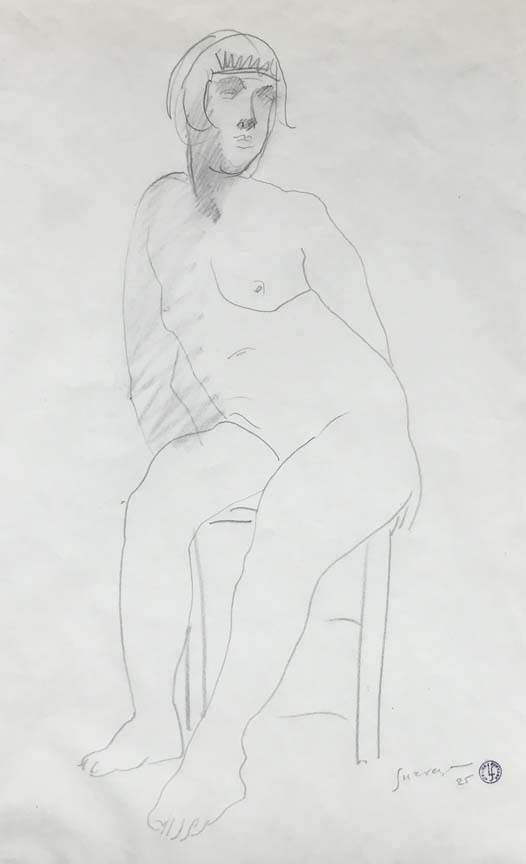

LEOPOLD SURVAGE
"SEATED NUDE"
PENCIL DRAWING, SIGNED, DATED
FRANCE, 1925
14.5 X 9 INCHES
Leopold Survage 1879 – 1968 Leopold Survage was born in Moscow in 1879. He studied at the Moscow School of Painting, Sculpture, and Architecture, where he associated with Archipenko, Larionov, and Malevich. Survage exhibited in Moscow in 1907 at the exhibition “La Guirlande”. He was bored with the rigidity of his artistic education in Moscow, then he discovered in the collection of a rich merchant the works of Manet, Gaugain and Matisse; which served as his introduction to modern art, and motivated him to move to Paris in 1908 In Paris began to study with Matisse at his academy on the Boulevard des Invalides. He was introduced into the art circles of Paris by his friend Archipenko, and exhibited with the Cubists at the Salon des Indépendants in 1911. He exhibited at the Salon d’Autumne in 1912 and throughout his career. In 1912-1913 he created a style of painting called “Rhythme Colore”, a style of painting bearing strong similarities to the abstract expressionist works which gained popularity 40 years later. These compositions were meant to convey the idea of music, a similar goal inspired much of Kandinsky’s painting. Many of Survage’s large paintings in this style are held by the Museum of Modern Art in New York. In 1914 Survage was found unfit for military service and was able to spend the war years painting on the Côte d’Azur. The importance of the “Rythme Colore” was immediately recognized by the most influential critic in the world at the time - Guillaume Apollinaire, who had “discovered” the cubists. Apollinaire wrote a preface for the catalog of Survage’s first one-man exhibition at Galerie Bongard in 1917. Appolinaire died on Armistice Day in 1918 after being wounded in battle several weeks earlier and Survage lost an important promoter of his work. Survage became a familiar face in the salon of Helen d’Oettingen, a writer, who surrounded herself with painters and sculptors, such as Picasso, Braque, Modigliani, Leger, Delaunay, Brancusi, Severini and Marcoussis. In 1919 Survage was one of the original founders of the Section d’Or along with Albert Gleizes, Georges Braque, Marcoussisi, and Ferat. In that year he was under contract to art dealer Leonce Rosenberg and his gallery “l’Effort Moderne” where he had three one-man exhibitions and participated in many group shows, including the famous “Masters of Cubism” In 1922 Survage received a commission from Diaghilev to design décor and costumes for Stravinsky’s ballet “Mara”. In1927 he had one-man exhibitions at the Galerie Granoff, Paris, and Kraushaar Gallery, New York and Chester Johnson Gallery, Chicago. Beginning in 1924 Survage took a series of vacations in the South, which marked a turning point in his art; he began applying bright colors and began a series of figure in landscape paintings, which were to become one of his hallmarks. Survage’s art went through several phases, the early “Rythme Colore”, his work after always showed a cubist sensibility, though in the mid 1920’s he returned to more traditional subjects and compositions. In the 1930’s his work showed a strong surrealist influence. In 1928 Survage exhibited in Russia at l’Exposition de la Peinture Français Moderne in Moscow and Leningrad. In 1929 he took part in the exhibition “Painting in Paris” at the Museum of Modern Art in New York, he had a one man show at Knoedler Gallery in New York. Survage exhibited all over the world in one-man shows, group shows and large exhibitions almost until his death in 1968. He won medals throughout, including 1937 (Paris), 1951(Genoa), 1964 (Turin, Italy), He was awarded the Chevalier de la Légion d’Honneur. Survage showed several large murals at the l’Exposition Universalle in Paris in 1937. His works are in the Museum of Modern Art of New York, Paris, Moscow, the Toronto Museum, Art Institute of Chicago and many others. |